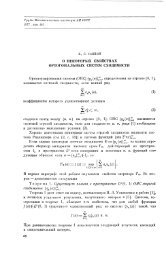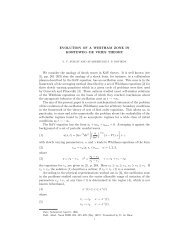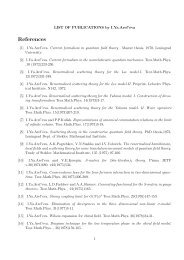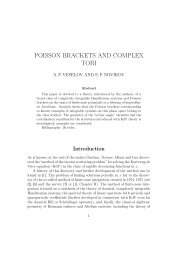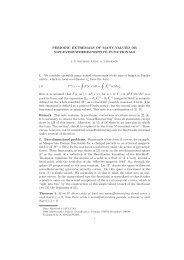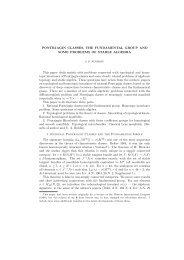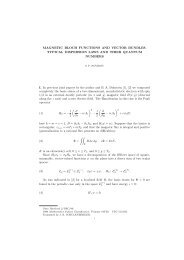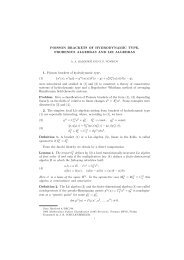A periodic problem for the Korteweg-de Vries equations, I.
A periodic problem for the Korteweg-de Vries equations, I.
A periodic problem for the Korteweg-de Vries equations, I.
Create successful ePaper yourself
Turn your PDF publications into a flip-book with our unique Google optimized e-Paper software.
2 S. P. NOVIKOVnumber of o<strong>the</strong>r <strong>equations</strong> have subsequently been found which admit <strong>the</strong> “Lax representation”˙L = [A, L] <strong>for</strong> a certain pair of operators A, L. P. Lax [7] and Gardner[6] have shown that <strong>the</strong> known polynomial integrals I n (u) = ∫ ∞−∞ P n(u, . . . , u (n) ) dxof <strong>the</strong> KV equation (<strong>the</strong> I n are expressed in terms of <strong>the</strong> spectrum of <strong>the</strong> operatorL) all <strong>de</strong>termine <strong>equations</strong>˙u = d δI ndx δu(x) , (1)admitting <strong>the</strong> Lax representation ˙L = [A n , L], where L = (d 2 /dx 2 ) + u and <strong>the</strong> A nare certain skew-symmetric operators of or<strong>de</strong>r 2n + 1,∫∫ ( ) uI 0 = u 2 ′2dx, I 1 =2 + u3 dx,∫ ( u′′2I 2 =2 − 5 2 u2 u ′′ + 5 )2 u4 dx,A 0 = d(dx , A 1 = 4 d3dx 3 − 3 u ddx + d )dx u ,A 2 = d5dx 5 − 5 2 u d3dx 3 − 15 d2u′4 dx 2 + 15u2 − 25u ′′ d8 dx + 15 8)(uu ′ − u′′′. (2)2We shall call <strong>the</strong>se <strong>equations</strong> “higher KV <strong>equations</strong>.” Fur<strong>the</strong>r, beginning with <strong>the</strong>papers [9, 10], a number of o<strong>the</strong>r important <strong>equations</strong> were found which admit<strong>the</strong> Lax representation ˙L = [A, L], where L is no longer a Schrödinger operator(and is not always symmetric). In <strong>the</strong> papers of L. D. Fad<strong>de</strong>ev, V. E. Zakharov,and A. B. Shabat ([10, 11, 12]) <strong>the</strong> nee<strong>de</strong>d generalization of scattering <strong>the</strong>ory wascarried out <strong>for</strong> <strong>the</strong> new operators which has ma<strong>de</strong> it possible to solve <strong>the</strong> direct andinverse <strong>problem</strong>s and to carry through <strong>the</strong> “Kruskal” integration of <strong>the</strong> Cauchy<strong>problem</strong> <strong>for</strong> rapidly <strong>de</strong>creasing (as x → ±∞) initial data. A consi<strong>de</strong>rable literaturehas recently been <strong>de</strong>voted to discovering such new <strong>equations</strong> and carrying over<strong>the</strong> Kruskal mechanism to <strong>the</strong>m. However, even <strong>for</strong> <strong>the</strong> original KV equation <strong>the</strong><strong>periodic</strong> <strong>problem</strong> has not moved <strong>for</strong>ward. The only new result in <strong>the</strong> <strong>periodic</strong> case,which was obtained by <strong>the</strong> method of Gardner, Green, Kruskal, and Miura, is <strong>the</strong><strong>the</strong>orem of Fad<strong>de</strong>ev and Zakharov to <strong>the</strong> effect that <strong>the</strong> eigenvalues of <strong>the</strong> operatorL are commuting integrals of <strong>the</strong> KV equation as a Hamiltonian system (we remarkthat <strong>the</strong> integrals <strong>the</strong>mselves can be expressed in a one-to-one manner in terms of<strong>the</strong> previously known polynomial integrals I n which are thus also involutive). Thisresult has not been used in an essential way until <strong>the</strong> present work, but here itplays an important role (cf. §2).The interaction of simple waves [solutions of <strong>the</strong> type u(x − ct), usually called“solitons”] are of major interest in <strong>the</strong> <strong>the</strong>ory of <strong>the</strong> KV equation. This interactionis <strong>de</strong>scribed by means of so-called “multisoliton solutions” where b(k) ≡ 0 <strong>for</strong> realk. 1 These solutions <strong>de</strong>cay into solitons <strong>for</strong> x, t → ±∞ and <strong>de</strong>scribe <strong>the</strong>ir interaction<strong>for</strong> finite t. For this case <strong>the</strong> Gel’fand–Levitan <strong>equations</strong> are completely solvable(cf., <strong>for</strong> example [8, 9]). Ano<strong>the</strong>r method of obtaining multisoliton solutions hasbeen <strong>de</strong>veloped in [13]. However, all <strong>the</strong>se results refer to <strong>the</strong> case of rapidly<strong>de</strong>creasing functions u(x). In <strong>the</strong> <strong>periodic</strong> case <strong>the</strong> solitons u(x − ct) of <strong>the</strong> KVequation are of a more complicated structure; <strong>the</strong>re are many more of <strong>the</strong>m and <strong>the</strong>ir1 I. M. Gel’fand has in<strong>for</strong>med <strong>the</strong> author that such potentials u(x) were first consi<strong>de</strong>red byBargmann.



